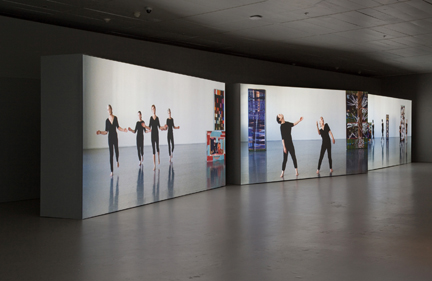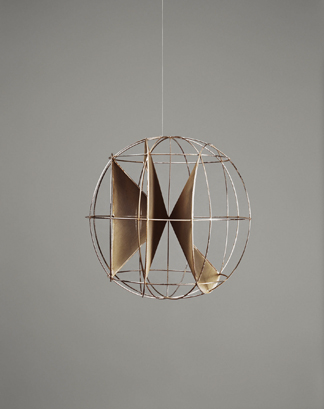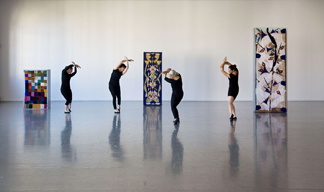Dance: Sharon Lockhart/Noa Eshkol — Eshkol’s dances as seen by Lockhart
By Dawn Lille
ART TIMES January/ February 2013
 Installation view of Sharon Lockhart | Noa Eshkol exhibition at The Jewish Museum, New York City. Courtesy of Gladstone Gallery, New York and Brussels, Blum & Poe, Los Angeles; and neugerriemschneider, Berlin. Photo by Alex Slade. |
Say the name Noa Eshkol in Israel and you get an immediate reaction. She was a dancer, but more importantly, a researcher and creator of movement studies based on the notation system she co-developed. She was also a textile artist and part of the bohemian arts circle in Israel even before it was a nation. Additionally, Eshkol (1924-2007) was the daughter of Levi Eshkol, the third prime minister of Israel.
The Los Angeles based artist Sharon Lockhart was introduced to Eshkol’s work in 2008 and the result is the exhibition Sharon Lockhart/ Noa Eshkol at the Jewish Museum through March 24th. If you are willing to visit slowly, look intently and allow the contents to enter your orbit of thinking, feeling and seeing, this special offering is most rewarding. In the words of one of the museum guards, “it takes time, you have to focus, and it becomes really interesting.”
Noa Eshkol was a theorist and philosopher, who, in the 1950’s, started to experiment with dance. She followed the music composition system of using a series of progressions based on set intervals, but her method used spatial intervals. This was a complete break from the traditional method of choreography.
Eshkol studied dance and Labanotation (another form of notation) but, desiring something more scientific, joined with the architect Avraham Wachman and created EWMN (Eshkol Wachman Movement Notation). She used this as a method to create movement cerebrally, not physically. The system is mathematical and logical, an analysis of movement based on the structure of the joints of the body. Here, every movement of an extremity is circular, taking place within an imaginary sphere, which is mapped using a series of vertical and horizontal coordinates.
 Sharon Lockhart, Models of Orbits in the System of Reference, Eshkol-Wachman Movement Notation System: Sphere Seven at Three Points in Its Rotation, 2011, three chromogenic prints, 20 ½ x 16 ½ inches. Courtesy of Gladstone Gallery, New York and Brussels, Blum & Poe, Los Angeles and neugerriemschneider, Berlin. © Sharon Lockhart, 2012. |
She would take a basic movement such as rising or sinking and then compose an entire dance on paper. She used only a few movements that repeated constantly, but their relation to the space around the body changed each time. Watching the resulting movement sequences, devoid of dynamics, can be compared to the music of Philip Glass. Eshkol’s main interest was in the possibilities of human movement.
Sharon Lockhart is primarily a filmmaker and photographer. Since the 1990’s she has been interested in creating bodies of work related to diverse communities, often not associated with the art world. She immerses herself in them and proceeds to distill their contents into work that is a reinterpretation or explanation and is actually a collaboration. Her subjects have ranged from a girls’ basketball team in Japan to children in the foothills of Sierra Nevada to workers in a Maine factory. She calls her museum installations a conversation between her subject and herself, a formalized translation of real life.
Eshkol is relatively unknown outside of Israel. Lockhart regards the engagement with her, achieved through intense contact with her students as well as writings, notebooks, photographs and ephemera, as one between two artists. She has attempted to understand what Eshkol, via the works she created, was doing aesthetically. Then she, as a conceptual artist, attempted to create a space “for a cultural/ social interaction with Eshkol and her dancers.”
Eshkol and Wachman created seven spherical models that demonstrate possible movement orbits within a single limb and used these for teaching their system. In the course of her research Lockhart discovered these, cleaned them off and photographed them at different points in their rotation.
The exhibition begins in two large spaces on the first floor of the museum. Room one shows a film installation entitled Five Dances and Nine Wall Carpets by Noa Eshkol. Each dance is seen in conjunction with Eshkol’s textiles, called wall carpets, selected and carefully placed as sets by Lockhart, who made the film. The dances are performed on floors colored battleship grey, the same color as the standing mountings of the wall carpets that are set at a 45-degree angle to the viewer. The walls in the film are a lighter gray. All the dances are performed to the beat of a metronome.
 Sharon Lockhart, production still from Five Dances and Nine Wall Carpets by Noa Eshkol, 2011. Courtesy of Gladstone Gallery, New York and Brussels, Blum & Poe, Los Angeles and neugerriemschneider, Berlin. © Sharon Lockhart, 2012. |
The first sight is of three huge floor to ceiling walls, or volumes as Lockhart calls them, extending over fifty feet. In the first are four dancers performing to the left of two large hangings on the right, one behind the other. In the second two dancers occupy stage center and there is one hanging on each side. In the third four dancers perform in front of three evenly spaced textile hangings placed on a slight diagonal.
In the two side films the dancers are a bit further back than the ones in the middle duet that has more sustained movement, not always in unison. Each differently timed channel stops briefly at the end of the dance and then starts again. Hence, in some miraculous way, one is able to watch all three simultaneously and slowly observe something being done to space, calling upon imagination and maybe memory as well.
If the viewer goes to the left of the room there are two more dances on the opposite wall. In one Lockhart arranged three hangings that occupy one half of the stage space. Two, the bird-like and leaf-like designs, are slightly in front of the third, with its large circular designs. In a sense, the dancers appear to be echoing the vertical strength of the textiles.
The second dance has a rectangular textile on the floor downstage to the viewer’s left and a narrower upright rectangular one on the right side to the back. The two dancers move in the space in between, creating a tension that suggests gravity. In all the movement there is an almost seamless flow that is not tense, but carefully controlled. In her initial working process Eshkol broke down each movement into infinitely smaller movements. This was in keeping with her intent to explore shapes and designs – how one could potentially move through space – not to record movement.
In the second exhibition room Lockhart displays her almost anthropologic research, when she got to know Eshkol through her archives, writing, company performances, interviews with followers and the work of her students. There are vitrines showing lovely drawings of the body in rotary, planal and conical movement, many examples of the notation system and five of Lockhart’s elegant photographs of the models of the orbits.
The exhibition continues on the third floor where Lockhart has chosen to display two of Eshkol’s carpets/wall hangings horizontally, placing them on platforms about a foot off the floor, where they resemble pieces of minimalist sculpture. Eleven more of Lockhart’s photographs of the spheres at different points in rotation hang on the walls vertically, seeming to frame the mixed media textiles below. These photographs, like the ones on the first floor, appear almost three dimensional; they suggest the movement possibilities within stillness, which was something Eshkol researched and illustrated her entire working life.
The two rugs, with their different colored, printed and shaped textiles, are full of movement. Lockhart has commented on what she sees as the exuberance of the wall hangings in comparison to the restraint of the dances. But she finds a point of connection in the formal and geometric motifs in both. The parameters of EWMN guide the movement and the hangings were put together with scraps of fabric, ruled by the dictum that they could never be cut, just joined or layered.
Toward the end of her life Eshkol concentrated on fine tuning and perfecting her research system and devoted more time to her textile designs. A fanatically hard worker, not interested in fame, she expected the same of others and could be larger than life and difficult. Lockhart, as a generous artist interested in exploring what is essential to human existence, has created an exhibition that is a joint venture with Eshkol, who she knows only by her work and legacy. And it all boils down to the body, space and time, with Lockhart weaving Eshkol’s work into a concept of humanity.
dawnlille@aol.com
